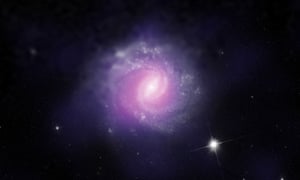Monster black holes may be lurking behind smokescreens in our cosmic backyard, say scientists. But they are still millions of light years away and much too distant to pose any threat to Earth.
Astronomers have discovered evidence of supermassive black holes at the centre of two of our galactic neighbours. One, the galaxy NGC 1448, is “just” 38m light years from our own body of stars, the Milky Way. The other, IC 3639, is 170m light years away. Both are classified as “active” galaxies that emit intense levels of radiation.
In each case the powerful black hole is concealed behind clouds of gas and dust. Scientists now believe most large galaxies have supermassive black holes at their cores, but many are hidden from view.
Black holes are places where gravity is so powerful it traps light and distorts time and space. They can only be detected from the last-gasp emissions of radiation from objects falling into them.
The hidden black holes were spotted by Nasa’s Nustar (nuclear spectroscopic telescope array) orbiting observatory.
British researchers from the universities of Durham and Southampton conducted analysis of the Nustar data. Ady Annuar, of the University of Durham’s centre for extragalactic astronomy, said: “These black holes are relatively close to the Milky Way, but they have remained hidden from us until now. They’re like monsters hiding under your bed.
“Their recent discoveries certainly call out the question of how many other supermassive black holes we are still missing, even in our nearby universe.”
Daniel Stern, project scientist for Nustar at Nasa’s jet propulsion laboratory, said: “It is exciting to use the power of Nustar to get important, unique information on these beasts, even in our cosmic backyard where they can be studied in detail.”
Quelle: theguardian

